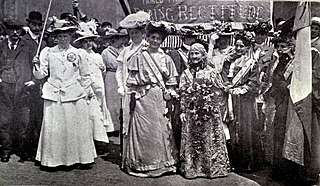Women's Sunday
Women's Sunday was a suffragette march and rally held in London on 21 June 1908. Organized by Emmeline Pankhurst's Women's Social and Political Union (WSPU) to persuade the Liberal government to support votes for women, it is thought to have been the largest demonstration that had been held at the time in the UK.[1]
| Women's Sunday | |||
|---|---|---|---|
| Part of first-wave feminism | |||
 Emmeline Pankhurst and Elizabeth Wolstenholme-Elmy of the Women's Social and Political Union at the head of the procession | |||
| Date | 21 June 1908 | ||
| Location | Hyde Park, London, England 51.508611°N 0.163611°W | ||
| Caused by | Fight for women's suffrage | ||
| Methods | Marches, direct action | ||
| Resulted in | Up to half a million people participate | ||
| Parties to the civil conflict | |||
| Lead figures | |||
| |||
| Preceded by: Mud March (NUWSS) | |||
Up to half a million[2] women and men from all over the country attended the event, while 30,000 women marched to Hyde Park in seven processions carrying 700 banners, including one that read "Not chivalry but justice".[3]
Processions
The event was organized by Emmeline Pethick-Lawrence, the WSPU's treasurer, and featured the WSPU colours—purple, white and green—for the first time in public.[4] Women were asked to wear white dresses, and leading up to the event shops offered displays of clothing for attendees. The Daily Chronicle noted: "White frocks will be prominent in the windows with a plentiful supply of dress accessories in violet and green."[5] In the two days before the event, over 10,000 scarves in the colours were sold, at two shillings and elevenpence each. Men wore ties in the colours.[6]

Stewards met attendees at the stations when they arrived in London in special trains from around the UK.[5] Around 30,000 women marched to Hyde Park in seven processions, each of which was headed by a chief marshal, who in turn led group marshals, captains and banner marshals. Emmeline Pankhurst, dressed in purple and accompanied by Elizabeth Wolstenholme-Elmy, led a procession from Euston Road. At Paddington, Annie Kenney led women from Wales, the Midlands and the west of England. Christabel Pankhurst and Emmeline Pethick-Lawrence led a procession from the Victoria Embankment. Five thousand marched from Kensington, along with five brass bands.[6]
Other attendees included Sylvia Pankhurst, Maud Pember Reeves, Mary Gawthorpe, Ethel Snowden, Keir Hardie,[6] Louie Cullen,[8] Hanna Sheehy-Skeffington, George Bernard Shaw, H. G. Wells, Thomas Hardy and Israel Zangwill.[4][9][10] There was said to be 300,000 spectators witnessing the 700 suffragists with their embroidered banners. The Daily Chronicle said that "Never, has so vast a throng gathered in London to witness a parade of political forces’.[7] Whilst the Standard said "From first to last it was a great meeting, daringly conceived, splendidly stage-managed, and successfully carried out. Hyde Park has probably never seen a greater crowd of people."[4]
See also
- Woman Suffrage Procession (Washington, D.C, 1913)
References
- Holten 2003, p. 46.
- Holten 2003, p. 46; The Times, 22 June 1908, p. 9.
- Atkinson 2018, 1748, 1832.
- Atkinson 2018, 1832.
- Tickner 1988, p. 93.
- Tickner 1988, p. 94.
- "Museum of London | Free museum in London". collections.museumoflondon.org.uk. Retrieved 20 April 2020.
- "Louie Cullen—part one". www.nla.gov.au. Retrieved 3 November 2019.
- "Crowds in Hyde Park on Women's Sunday: 1908", Museum of London.
- Bloom, Christina. "Suffragettes in Hyde Park on Women's Sunday; 1908", Museum of London.
Works cited
- Atkinson, Diane (2018). Rise Up Women!: The Remarkable Lives of the Suffragettes. London: Bloomsbury Publishing.CS1 maint: ref=harv (link)
- Holten, Sandra Stanley (2003) [1986]. Feminism and Democracy: Women's Suffrage and Reform Politics in Britain, 1900–1918. Cambridge: Cambridge University Press.CS1 maint: ref=harv (link)
- Tickner, Lisa (1988). The Spectacle of Women: Imagery of the Suffrage Campaign 1907–14. Chicago: University of Chicago Press.CS1 maint: ref=harv (link)
Further reading
- "Women's Sunday". Votes for Women. 18 June 1908, pp. 243–246.
- "'Women's Sunday': Hyde Park Rally, 21st June 1908", University of Kent.
- "Suffragette timeline: the long march to votes for women", The Daily Telegraph.
- Pethick-Lawrence, Emmeline (1938). My Part in a Changing World. London: Victor Gollanz.
- Purvis, June (1995). "The prison experiences of the suffragettes in Edwardian Britain". Women's History Review. 4 (1): 103–133. doi:10.1080/09612029500200073.